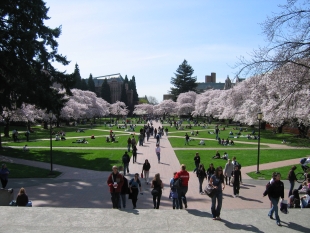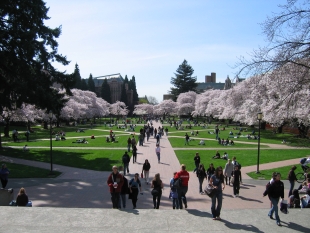The Ivy League is the greenest of them all, according to the EPA, which today announced the college and university winners of the Green Power challenge — a competition to motivate American schools to purchase more renewable energy. Participating schools compete within their athletic conferences to purchase the most certified green power, but conferences only qualify if each purchases more than 10 million kWh in aggregate.
 University of Washington.The Ivies, anchored by University of Pennsylvania’s purchase of 192 million kWh, chalked up the best conference performance, purchasing a total of 225 million kWh of green power. Here in the Pacific Northwest, four colleges and universities bested their respective conferences: Oregon State University (Pacific-10), Western Washington University (Great Northwest Athletic Conference), The Evergreen State College (Cascade Collegiate Conference), and Pacific Lutheran University (Northwest Conference).
University of Washington.The Ivies, anchored by University of Pennsylvania’s purchase of 192 million kWh, chalked up the best conference performance, purchasing a total of 225 million kWh of green power. Here in the Pacific Northwest, four colleges and universities bested their respective conferences: Oregon State University (Pacific-10), Western Washington University (Great Northwest Athletic Conference), The Evergreen State College (Cascade Collegiate Conference), and Pacific Lutheran University (Northwest Conference).
But as remarkable as these collegiate green-power investments are, the competition itself is a bit thin. For instance, participation in this challenge is voluntary, so even though Oregon State won in the Pac-10, it only had to beat the University of Washington and Stanford University’s Synergy House, a cooperative living residence. Other major Pac-10 schools such as USC, UCLA, and Arizona State did not participate.
What’s more, the competition results are misleading. UW is only recognized for a purchase of 14.9 million kWh of green power, even though the university is entirely powered by a portfolio of carbon-free electricity. John Chapman, director of campus engineering and operations, explained that 94 percent of UW’s power comes from hydropower, which the EPA does not count as green. The 6 percent the EPA does credit comes from the the renewable energy certificates that the university purchases to compensate for the portion of its utility’s electricity portfolio that is fossil-fuel derived.
“We are completely powered by renewable energy and carbon-neutral electricity, but the EPA does not count hydro, and it does not look kindly on utility-purchased electricity,” said Chapman. “They want you to buy the credits and certificates.”
Oregon State’s win comes from its purchase of renewable energy certificates for 75 percent of the university’s need. “We buy 75 percent of our power in renewable energy certificates from the Bonneville Environmental Foundation. It’s mostly windpower,” said Brandon Trelstad, sustainability coordinator for Oregon State.
But the Green Power challenge wasn’t a motivating factor Oregon State’s win. The university won in 2008 with the exact same amount of green power (66.7 million kWh), as it did this year. The green-power investment is primarily funded (and limited) by a student fee of $8.50 per student per term, which was voted on by the student body in the spring of 2007.
“Nothing really significant has chaged in our power purchasing,” said Trelstad.
Like Oregon State, it seems that most collegiate winners were celebrated for doing what they were already doing. Overall winner U. Penn. purchased over 192 million kWh of green power to win this year, but the Ivy League leader posted the exact same amount in 2008 [PDF]. In the three years that the challenge has run, the overall purchasing leaders have stayed the same — U. Penn., New York University, and Penn State — with little variability elsewhere in the field of competitors (see 2007 results [PDF]). So what good is a Green Power challenge that fails to motivate colleges to actually green their power purchasing habits?
I would have liked to pose this question to the EPA, but the contact did not return my calls.
The Green Power challenge is one of many tools with which to rank the greeniness of colleges and universities in the U.S. For more info, check out America’s Greenest Campus, the Princeton Review’s green rating honor roll, and Grist’s list of the 15 greenest colleges.



